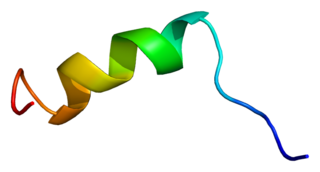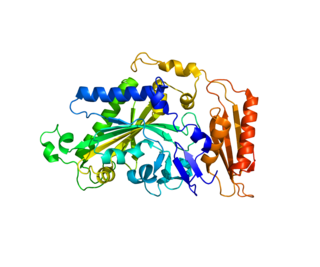
CDKL5 is a gene that provides instructions for making a protein called cyclin-dependent kinase-like 5 also known as serine/threonine kinase 9 (STK9) that is essential for normal brain development. Mutations in the gene can cause deficiencies in the protein. The gene regulates neuronal morphology through cytoplasmic signaling and controlling gene expression. The CDKL5 protein acts as a kinase, which is an enzyme that changes the activity of other proteins by adding a cluster of oxygen and phosphorus atoms at specific positions. Researchers are currently working to determine which proteins are targeted by the CDKL5 protein.

Aminomethyltransferase is an enzyme that catabolizes the creation of methylenetetrahydrofolate. It is part of the glycine decarboxylase complex.

ADGRV1, also known as G protein-coupled receptor 98 (GPR98) or Very Large G-protein coupled receptor 1 (VLGR1), is a protein that in humans is encoded by the GPR98 gene. Several alternatively spliced transcripts have been described.

Syntaxin-binding protein 1 is a protein that in humans is encoded by the STXBP1 gene. This gene encodes a syntaxin-binding protein. The encoded protein appears to play a role in release of neurotransmitters via regulation of syntaxin, a transmembrane attachment protein receptor. Mutations in this gene have been associated with neurological disorders including epilepsy, intellectual disability, and movement disorders.

Sodium channel protein type 2 subunit alpha, is a protein that in humans is encoded by the SCN2A gene. Functional sodium channels contain an ion conductive alpha subunit and one or more regulatory beta subunits. Sodium channels which contain sodium channel protein type 2 subunit alpha are sometimes called Nav1.2 channels.

ATP-sensitive inward rectifier potassium channel 10 is a protein that in humans is encoded by the KCNJ10 gene.

Ubiquitin-conjugating enzyme E2 A is a protein that in humans is encoded by the UBE2A gene.

Lactosylceramide alpha-2,3-sialyltransferase is an enzyme that in humans is encoded by the ST3GAL5 gene.

Elongation factor G 1, mitochondrial is a protein that in humans is encoded by the GFM1 gene. It is an EF-G homolog.

Rho-related BTB domain-containing protein 2 is a protein that in humans is encoded by the RHOBTB2 gene.

Phenylalanyl-tRNA synthetase, mitochondrial (FARS2) is an enzyme that in humans is encoded by the FARS2 gene. This protein encoded by FARS2 localizes to the mitochondrion and plays a role in mitochondrial protein translation. Mutations in this gene have been associated with combined oxidative phosphorylation deficiency 14, also known as Alpers encephalopathy, as well as spastic paraplegia 77 and infantile-onset epilepsy and cytochrome c oxidase deficiency.

Chromodomain-helicase-DNA-binding protein 2 is an enzyme that in humans is encoded by the CHD2 gene.

Seizure protein 6 homolog is a protein that in humans is encoded by the SEZ6 gene.

Spatacsin is a protein that in humans is encoded by the SPG11 gene.

Mitochondrial import inner membrane translocase subunit TIM50 is a protein that in humans is encoded by the TIMM50 gene. Tim50 is a subunit of the Tim23 translocase complex in the inner mitochondrial membrane. Mutations in TIMM50 can lead to epilepsy, severe intellectual disability, and 3-methylglutaconic aciduria. TIMM50 expression is increased in breast cancer cells and decreased in hypertrophic hearts.

Ubiquinone biosynthesis protein COQ9, mitochondrial, also known as coenzyme Q9 homolog (COQ9), is a protein that in humans is encoded by the COQ9 gene.

Solute carrier family 13 (sodium-dependent citrate transporter), member 5 also known as the Na+/citrate cotransporter or mIndy is a protein that in humans is encoded by the SLC13A5 gene. It is the mammalian homolog of the fly Indy gene.

TBC1 domain family, member 24 is a protein that in humans is encoded by the TBC1D24 gene.

Solute carrier family 25 member 22 is a protein that in humans is encoded by the SLC25A22 gene. This gene encodes a mitochondrial glutamate carrier. Mutations in this gene are associated with early infantile epileptic encephalopathy. Expression of this gene is increased in colorectal tumor cells.

Prickle planar cell polarity protein 2 is a protein that in humans is encoded by the PRICKLE2 gene.



















